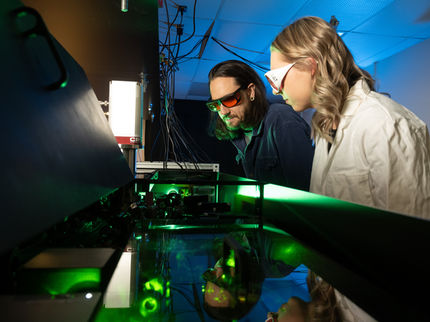Twisting Under the Stroboscope – Controlling Crystal Lattices of Hybrid Solar Cell Materials with Terahertz Light
Advertisement
To overcome global energy challenges and fight the looming environmental crisis, researchers around the world investigate new materials for converting sunlight into electricity. Some of the most promising candidates for high-efficiency low-cost solar cell applications are based on lead halide perovskite (LHP) semiconductors. Despite record-breaking solar cell prototypes, the microscopic origin of the surprisingly excellent optoelectronic performance of this material class is still not completely understood. Now, an international team of physicists and chemists from Fritz Haber Institute of the Max Planck Society, École Polytechnique in Paris, Columbia University in New York, and the Free University in Berlin demonstrated laser-driven control of fundamental motions of the LHP atomic lattice. By applying a sudden electric field spike faster than a trillionth of a second (picosecond) in the form of a single light cycle of far-infrared Terahertz radiation, the investigators unveiled the ultrafast lattice response, which might contribute to a dynamic protection mechanism for electric charges. This precise control over the atomic twist motions will allow to create novel non-equilibrium material properties, potentially providing hints for designing the solar cell material of the future.

A single cycle of intense Terahertz laser light (red) rapidly twists the atomic lattice of a hybrid organic-inorganic solar cell material. The resulting ultrafast shaking of the lead halide lattice is traced by stroboscopic snapshots using visible laser pulses (green). The observed lattice response provides novel insights into microscopic mechanisms for protecting electric charges and paves the way for ultrafast control of the material’s optoelectronic properties.
© Maximilian Frenzel, FHI
The investigated hybrid LHP solar cell materials consist of an inorganic crystal lattice, which acts as periodic cages for hosting organic molecules. The interplay of free electronic charges with this hybrid lattice and its impurities determines how much electricity can be extracted from the sun light’s energy. Understanding this complicated interaction might be the key for a microscopic understanding of the outstanding optoelectronic performance of LHPs. Researchers from Fritz Haber Institute in Berlin and their international colleagues have now been able to isolate the lattice response to an electric field on timescales faster than 100 femtoseconds, that is one tenth of a trillionth of a second. The electric field has been applied by an intense laser pulse containing only a single cycle of far-infrared, so-called Terahertz (THz), light. “This THz field is so strong and so fast that it may mimic the local electric field of an excited charge carrier immediately after the absorption of a quantum of sunlight,” explains Maximilian Frenzel, one of the main authors performing the experiments.
By this approach, the investigators observe a concerted motion of the crystal lattice, mainly consisting of back and forth tilting of the octahedral building blocks of the inorganic cage. These nonlinearly excited vibrations can lead to - so far neglected - higher order screening effects, contributing to an often discussed charge carrier protection mechanism. “Moreover, the related tilting angle plays a dominating role in determining the fundamental material properties, such as the crystallographic phase or electronic bandgap,” clarifies Dr. Sebastian Maehrlein, leader of the international research project. Thus, instead of static chemical tuning of material properties, ultrafast dynamic material design comes into reach: “As we can now modulate these twist angles by a single THz light cycle,” summarizes Dr. Maehrlein, “in future we might be able to control material properties on demand or even discover novel exotic states of this emerging material class.” By assessing such dynamic states of matter, the researchers hope to contribute some hints for designing the energy materials of the future.
































































